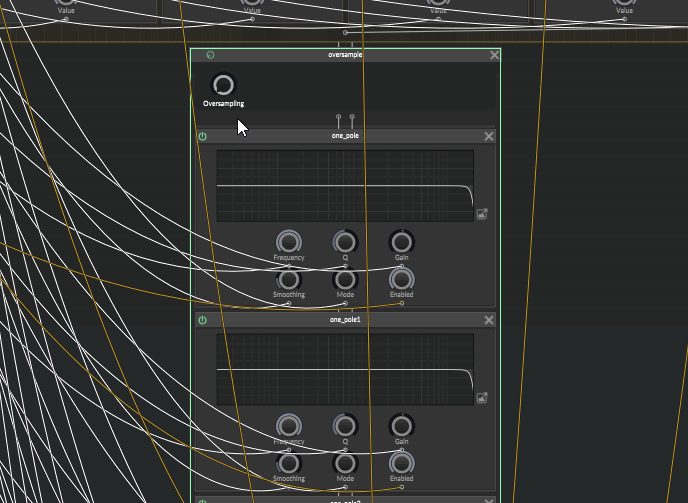Oversampling a One Pole Filter Limits Frequency Range?
-

Using the oversample node with a one pole filter results in the frequency range being reduced. It's audible as well, it sounds the way it looks.
I hoped oversampling a filter would eliminate filter cramping (due to working sampling rate).
Am I approaching this the wrong way?
-
@aaronventure you could do without oversampling the filters. You only need to use it in nodes like saturation and compression cause that's where aliasing occurs.
-
@Dan-Korneff here's a good video on the topic https://youtu.be/lqOBgt4DX20
-
@aaronventure the video says that Oversampling can be used as a brute force attempt to correct the issue, with potential downsides.
The solution is to stack filters without oversampling. -
to clear up what's happening in my example: turning on oversampling for filters affects the actual frequency of the filters. this seems to be a bug.
Also, the filters in HISE seem to cramp at Nyquist frequency to avoid aliasing. Great! But if I don't want the cramping behavior, I should be able to turn on oversampling, where they internally run at higher sampling rate = higher Nyquist and won't cramp at 22.05/24 kHz anymore.
-
The way I understand this (but I am very limited on the topic) is that:
- The oversampling issue, well, seems to be an issue (really???
 ) because the coefficient should be recalculated for the new samplerate so the freq is respected
) because the coefficient should be recalculated for the new samplerate so the freq is respected - The zero at nyquist is depending on the filter type and is a normal behaviour for a simple one pole filter
- The oversampling issue, well, seems to be an issue (really???
-
@ustk said in Oversampling a One Pole Filter Limits Frequency Range?:
The zero at nyquist is depending on the filter type and is a normal behaviour for a simple one pole filter
I mean, it behaves the way you write it. It's preferred, for sure, you really don't want any aliasing in your audio. How exactly it cramps varies between developers, as you can see in Dan Worrall's video.
For filters that have the sort of log cramp like the ones here in HISE, where the slope seems to increase as it approaches Nyquist, normally if you want to bypass that kind of behavior, you just turn on oversampling (in Reaper you can handle daw-based oversampling per plugin, for example).
-
@aaronventure To my understanding,
- oversampling a filter won't remove the zero at nyquist but simply push it further to the new nyquist where nothing is audible (for instance with an OS x2, from 22050 to 44100 if original SR = 44.1kHz or 24000 to 48000 if original SR = 48Khz).
- What you call the "log cramp that increases" is simply a zero in the filter design, it's more a drawback due to discretisation of filters rather than something anyone wants.
- There no aliasing if you don't have a zero at nyquist, because filters don't produce sound. There will be aliasing only if the signal that enters the filter already has harmonics above nyquist.
- To my opinion, if the zero at nyquist is an issue in your design (which I assume it is for many designs) then you've chosen the wrong filter. Some filters are designed to compensate for this issue (I have no precise example in the top of my head except generally for all virtual analog filter designs)
Oversampling is one of the solutions, but to me if the zero is an issue then the filter choice is wrong in the first place
That been said, there shouldn't be any issue when oversampling a filter so I don't know if Hise handles it properly